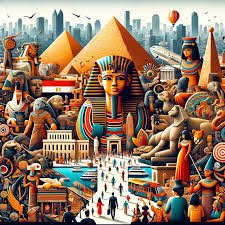The evolution of cultural practices is a fascinating journey that spans millennia, encompassing countless traditions, beliefs, and innovations. From ancient times to modern traditions, humanity has carried forward practices, adapted them, and created new ones. In this blog, we explore how traditions have evolved, how they shape our world today, and their significance in maintaining cultural identity.
1. Cultural Practices in Ancient Times
Cultural practices in ancient times were deeply connected to the natural world and survival. In ancient civilizations, rituals often centered around agriculture, fertility, and religious beliefs. For example, the ancient Egyptians practiced elaborate burial rites as a way to honor the dead and prepare for the afterlife, while the Romans celebrated Saturnalia, a festival to honor the god Saturn, marking the end of the agricultural season.
These ancient traditions were not merely social events but were essential to maintaining harmony between people and their environment. They influenced everything from governance to daily routines. Over time, these practices formed the foundations of modern customs, demonstrating how deeply rooted our cultural identity is in history.
2. Adapting Traditions for Modern Times
As civilizations progressed, many ancient traditions have either evolved or been adapted to fit the needs and values of contemporary society. One prime example is how harvest festivals once celebrated in agrarian cultures have transformed into national holidays, such as Thanksgiving in the United States. What began as a religious or community-based tradition has taken on new meanings, emphasizing family, gratitude, and giving back to the community.
This transition from ancient times to modern traditions reflects our society’s ability to blend old customs with new ideas, ensuring they remain relevant in today’s world. Technology, globalization, and the rise of interconnected societies have all played a part in reshaping traditions, ensuring their survival while allowing them to be celebrated in new ways.
3. Preserving Cultural Identity Through Traditions
Traditions are more than just rituals passed down from generation to generation—they are the threads that weave cultural identity. Throughout history, communities have preserved their unique customs despite challenges like colonization, migration, and modernization. From the indigenous tribes of the Americas to the ancient practices of Eastern cultures, many traditional ceremonies continue to hold significant importance today.
One of the most prominent ways in which modern traditions continue to thrive is through festivals, ceremonies, and celebrations. For example, Diwali, the Festival of Lights, is celebrated worldwide by millions of people, reflecting both religious devotion and the enduring power of community gathering.
4. The Role of Technology in Modern Traditions
Technology has undoubtedly played a vital role in reshaping how traditions are practiced today. In the digital age, social media and the internet have become crucial platforms for sharing cultural practices. Festivals that were once confined to specific regions now have global reach, allowing people from diverse backgrounds to experience traditions from different cultures.
The preservation of oral traditions, which were historically passed down through spoken word, has also benefited greatly from technological advancements. Video recordings, podcasts, and social media have helped preserve languages, songs, and rituals that might have otherwise faded away with time. This digital transformation of ancient traditions to modern times offers new opportunities to keep cultural practices alive.
5. Why Traditions Matter in the Modern World
The continuity of traditions from ancient times to modern traditions serves as a reminder of our shared human history. Traditions help foster a sense of belonging, connection, and continuity, providing people with a sense of stability in an ever-changing world. As the pace of globalization continues to accelerate, the importance of preserving and adapting traditions becomes even more crucial.
Traditions are not static; they evolve, adapt, and grow with society, ensuring their relevance across generations. In the modern world, traditions offer a bridge to the past while opening doors to future interpretations, ensuring that the values and cultural practices that shaped human civilization continue to thrive.
Conclusion
From ancient times to modern traditions, the evolution of cultural practices demonstrates the resilience and adaptability of human society. As we continue to celebrate and adapt our customs, these traditions serve not only as a connection to our history but also as a guide for future generations. By honoring the past and embracing the future, we ensure that cultural heritage remains a vital part of our collective identity.
From Ancient Times to Modern Traditions explores the evolution of societies, cultures, and knowledge throughout history. The journey from ancient civilizations to contemporary practices highlights the continuous advancement of human understanding, traditions, and education. Whether it’s the development of language, scientific discoveries, or artistic expressions, history serves as a foundation for modern learning and innovation.
In this context, Educa Santillana plays a crucial role in bridging historical knowledge with modern educational methodologies. By incorporating historical insights into its learning resources, Educa Santillana helps students and educators understand the significance of past traditions while adapting them to present and future advancements. Just as societies have evolved, education continues to transform, ensuring that knowledge remains accessible and impactful.
By linking From Ancient Times to Modern Traditions with Educa Santillana, we see how history and education work together to shape the future. Explore how ancient wisdom and modern teaching techniques merge to create a comprehensive learning experience that enriches knowledge across generations!





